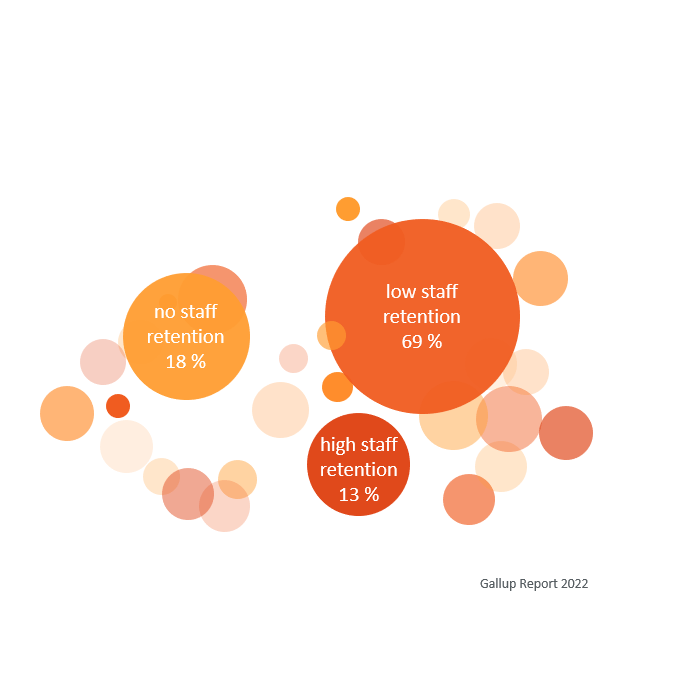Employee retention
Strategic personnel development and the creation of a good working atmosphere are key success factors in which managers play a decisive role. In this article, we would like to share approaches with a holistic view on how this can succeed.

Successfully implement employee retention
Employee retention is the ability of a company to keep its employees over a longer period of time. Easy to say, but the chaos at German airports last summer due to a lack of ground staff alone showed us how challenging it is to retain employees and motivate them over the long term.
This requires a targeted strategy that is aligned with both employee needs and corporate goals. Effective retention strategies include creating a positive work environment, offering competitive compensation and benefits packages, recognizing and rewarding good performance, and fostering open communication between employees and management – but there are many reasons why employees still leave their jobs, from poor management to lack of development opportunities.
Why is employee retention important?

Why is employee retention important?
Employees who feel valued and who identify with their company generally have a higher level of commitment and are more willing to use their competencies and skills to advance the company.
Emotional commitment of employees
The current Gallup Engagement Index1 reveals the state of emotional commitment among employees: for every 100 employees in an average company, only 13 people have a high level of emotional commitment. In contrast, 69 people have only a low level of emotional commitment and 18 people have no emotional commitment at all.
This means that the emotional attachment of Germany’s employees to their employer is at its lowest level since 2012.
43% with low attachment and 80% with no attachment plan to change within the next year.
By contrast, if we look at the group who feel strongly committed to their company, 86% still intend to be employed by their current employer in a year’s time, and 68% of those surveyed intend to stay for the next three years.
Thus, as retention increases, the willingness to switch seems to decrease.
If we now take a look at the vacancy time of 145 days for a new position – according to the German Federal Employment Agency2 it has increased by 23 days in 2022 compared to the previous year – the dramatic nature of retaining employees becomes even clearer.
Gall up Report: Employee retention continues to fall

Leadership cultures in companies in 2023 and in the future
As the labor market becomes more competitive and employees have more options and choices than ever before, employers must differentiate themselves from their competitors and create a work environment that is attractive to employees.
Leaders play an important role in this, ensuring that employees are put first and that growth, experience and learning are encouraged.
After all, it is still the people who make the difference and who will have to be nurtured and cared for in the coming years due to demographic developments. This is where strategic personnel development comes in to support employees and managers, because it is important to develop the competencies of employees today and to promote the talents of tomorrow.
If you look at the current Hays HR Report on the subject of employee retention – an empirical study by the Institute for Employment and Employability IBE and Hays3 – the working atmosphere is in first place and has the greatest influence.
In this context, the topic of “work-life balance” is coming into focus – a topic to which the younger generations attach great importance.
In addition, managers should recognize the performance of their employees, deal with them fairly and take sufficient time for their employees’ concerns, according to one of the results of the survey – in other words, giving and receiving regular feedback is and remains an important aspect of employee retention.
Through feedback discussions, companies set clear expectations and show appreciation towards their employees. In turn, feedback enables employees to develop and improve and gives both sides a platform to identify and resolve difficulties.
Increased needs, e.g.
- for a better work-life balance,
- flexible working hours and locations, or
- emotional commitment
show that, on the one hand, generations X and Y now represent a fixed size of the workforce and their requirements are coming to the fore.
On the other hand, it also shows how the world of work has changed in recent years.
But doing something new, promoting innovation and changing management cultures – this is definitely associated with risks and requires courage or courageous decisions in companies and among managers.

Before the tying, there is the onboarding…
Well-designed onboarding processes are critical to making new employees feel welcome and ready to contribute to the company.
Onboarding – Opportunity for executives
Onboarding – in addition to the application process – shapes the first contact between new employees and their manager, team and employer, and thus has a significant impact on further interaction in everyday working life.
Effective onboarding processes are therefore associated with higher job satisfaction, greater employee engagement and lower turnover rates.
It is therefore important for companies to invest time and resources in developing and implementing effective onboarding processes to prepare new employees for their jobs and foster a positive work culture.
It may not be a secret that HR departments are increasingly concerned with issues such as employer branding and onboarding processes – but what about executives?
What is their part in a “good” onboarding and what effect does this have on the employees?
If managers understand the topic of onboarding not as “…that’s our HR’s responsibility”, but instead become aware of their opportunities to influence the development of their employees effectively right from the start, the likelihood of retaining new employees in the longer term increases.
If managers see onboarding as an opportunity, then they can, for example,…..
- Identify problems and sources of interference at an early stage.
- Take action to eliminate them.
- Facilitate good collaboration.
- View probationary period as an opportunity for both sides to identify a lack of fit and draw consequences.
Trends
If you look at the trends in employee retention or increasing employer attractiveness, you can’t avoid the megatrend “workation” – the word is a combination of work and vacation and refers to a temporary stay abroad in which phases of professional activity alternate with recovery phases.
According to a recent study by PwC4 , younger professionals under the age of 40 in particular often want to work regardless of location – even across borders. In other words, they want greater flexibility that goes well beyond the home office.
Companies will certainly have to deal with the new issues that arise, such as clarification of tax and employment law, but workations are increasingly becoming an effective HR management tool for attracting and retaining employees.
Conclusion
Successful employee retention will be of central importance in the coming years in order to avoid an additional burden on the existing workforce, slumps in sales, and overall economic growth and prosperity losses.
The focus here is on realigning management cultures to meet the needs and wishes of employees.
Open, transparent and appreciative interaction with one another will become increasingly important. This is the only way to retain a satisfied and motivated workforce in the long term – because ultimately it is people who make the difference and have a decisive influence on the success of a company.
Author
Anette Göll is head of the business field “Leadership” at CONTUR. Her work focuses on the development, implementation and realization of architectures of development programs for (international) executives as well as on consulting and coaching, especially on the topics of extended leadership responsibility, challenging communication situations and managing change. The change of leadership cultures is especially close to her heart.

Author
Anette Göll is head of the business field “Leadership” at CONTUR. Her work focuses on the development, implementation and realization of architectures of development programs for (international) executives as well as on consulting and coaching, especially on the topics of extended leadership responsibility, challenging communication situations and managing change. The change of leadership cultures is especially close to her heart.
Resources
1
Copyright © 2023 Gallup, Inc.- Gallup Engagement Index
2
Bundesagentur für Arbeit
3
HR-Report 2023 – Mitarbeiterbindung – Hays AG in Zusammenarbeit mit dem Institut für Beschäftigung und Employability IBE
4
Workation zwischen Wunsch und Wirklichkeit (pwc.de)



